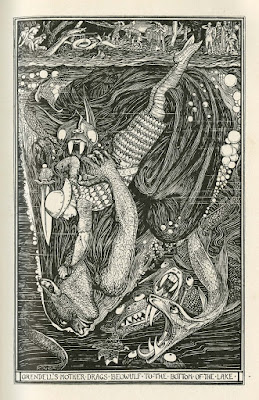A number of weeks ago, I got it into my head to start translating Beowulf after my good friend and colleague, Victoria Koivisto-Kokko, mentioned something about editions. I remembered my eternal desire to produce one in Cork slang, and thought, sure jaysus why not, and alas, Boyo-wulf (name courtesy of Ciarán Kavanagh) was conceived.
While this is first and foremost a translation with a humorous intention, as someone who has studied translation theory and translations of Beowulf for four years, there is an element of seriousness to it. I am translating this from the Old English itself (generally using Klaeber's edition for line numbers), and looking to R.D. Fulk's and Kevin Kiernan's editions for backup.
Dictionary-wise, I am using the Bosworth-Toller and Clark-Hall dictionaries (both controversial in their own ways). Unfortunately I don't have free access to the DOE.
I have decided on a prose translation because, in short, it is quite loose in some places in order that it reflect the purity of the daycent Cork slang.
Speaking of Cork slang, a dictionary of it can be found through the following links:
 |
| here |
 |
| here |
.
Boyo-wulf ll. 1-19
Old English:
Hwæt. We Gardena in geardagum,
þeodcyninga, þrym gefrunon,
hu ða æþelingas ellen fremedon.
Oft Scyld Scefing sceaþena þreatum,
monegum mægþum, meodosetla ofteah,
egsode eorlas. Syððan ærest wearð
feasceaft funden, he þæs frofre gebad,
weox under wolcnum, weorðmyndum þah,
oðþæt him æghwylc þara ymbsittendra
ofer hronrade hyran scolde,
gomban gyldan. þæt wæs god cyning.
ðæm eafera wæs æfter cenned,
geong in geardum, þone god sende
folce to frofre; fyrenðearfe ongeat
þe hie ær drugon aldorlease
lange hwile. Him þæs liffrea,
wuldres wealdend, woroldare forgeaf;
Beowulf wæs breme blæd wide sprang,
Scyldes eafera Scedelandum in.
Translation:
C'mere to me! We the Spear-Danes, well we've all heard of those pure daycent kings from donkeys' years, and how the mad yokes of princes did alright for themselves. Sure half the time Scyld Scefing was off among a rake of enemies, pulling the mead-seats out from under their arses, scaring the shit out of the boss-men, ever since he was found skint as a young fella.
He then found joy, good man himself, did just mighty beneath the heavens, lapped up fierce respect 'til all the bais across the whale-road had to obey him and cough up a bit of moola - That was some class king, like.
And so then came along a son, young fella bating around the gaff, sent from the lord himself (bless us and save us), to help the locals. God'd had an old gawkeen and saw they were up to bloody here with it without a king. So the Lord God Almighty (bless us and save us) granted him migthy respect, and Scyld's son, Beowulf (this is a different fella now alright) was a pure ledge like, even the dogs on the street (or at least those in the southern regions of Scandinavia that is) knew who he was.




















